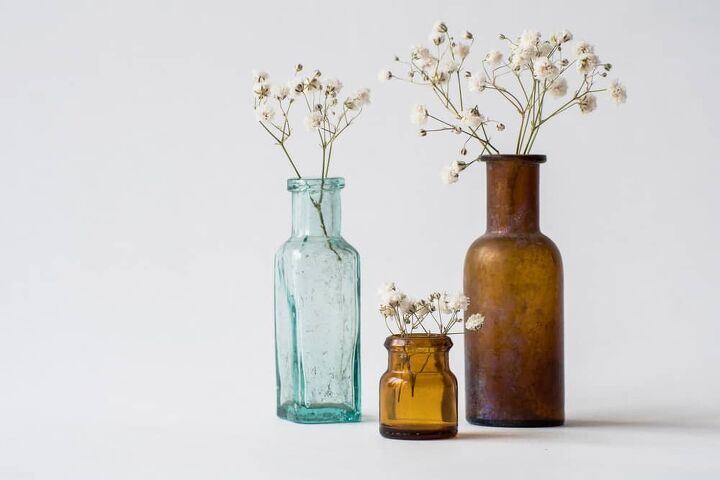How To Identify Antique And Vintage Vases (Quickly & Easily!)

Furniture and all home accessories come in so many styles and types; learning them all boggles the mind. But if one item remains popular and stands the test of time, it’s a genuine antique vase. Antique vases are not only treasured pieces, but they also tell stories of their own existence and being.
One way to identify an antique vase is to check for the artist’s name on the bottom of the vase. If you see that, along with a company name, you may have a genuine antique on your hands. If your vase is made of glass, the texture, thickness, and composition can also indicate your piece’s age.
Antique vases consist of various materials, but the most popular mediums are porcelain and glass. Specific characteristics help identify a reproduction from the real deal and indicate the value or lack thereof. Here are a few steps to sort out the wannabe’s from the genuine article.
A Step-By-Step Guide to Identifying Antique Vases
Tools for the Job
- Cloth
- Table
- Magnifying glass
- Small flashlight
- Camera
- Antiques Catalog
Step 1: Check the Bottom of the Vase
Place your vase upside down on a flat, padded surface and check the bottom for logos, signatures, or company names. These marks may be inked, painted on, or engraved on the piece. Many manufacturers used different signatures over the years to represent the creation date of a particular piece.
For glass or crystal vases, these marks may just be faint, etched signatures. Pottery or porcelain vases will have the maker’s mark stamped or inscribed, while silver will be marked “sterling” or “925”. This hallmark on silver vases usually accompanies the factory name and date of manufacture.
If you see an aged label or factory sticker, do not remove it! This piece of paper will help authenticate your vase and subsequent valuation.
Step 2: Identify the Mark
Once you find it, use an Internet search engine to identify the maker’s mark. You may also do a reverse search by taking a picture of the mark and uploading it.
Then, you can try to find similar or related images on the web. If you prefer doing things the old-fashioned way, proceed to your local library and peruse a glossary of antique marks.
Antique catalogs are also a valuable tool in identifying marks. If none of these methods bear fruit, it may be time to visit your friendly neighborhood antique appraiser.
One popular maker’s mark is the word NIPPON, which were vases made in Japan at the turn of the 20th century. Imported to the United States prior to 1921, these NIPPON-marked vases are certified antiques. “NIPPON” would usually be accompanied by a date and a manufacturer’s name.
Step 3: Check for an Overmark
An overmark is precisely that; a mark placed over the original maker’s mark. Keep your vase turned over and inspect for a stamp that covers up the maker’s mark. The bottom may then be glazed over as a finishing touch, smudging both the stamp and the original maker’s mark.
An overmark is an exciting thing. Its presence most likely indicates that the vase has a manufacture date sometime between 1880-1930. Additionally, many of these vases were imports from Europe.
Step 4: Inspect the Edges
Many antique glass vases were hand blown and the edges hand polished by their designers. Upon inspection, you will notice the edges to be smoother and shinier than the rest of the vase. Although modern designers employ this technique, the finer edges plus a maker’s mark would be evidence of it being antique.
Step 4: Check Out the Composition
The undoubted presence of reproductions, even counterfeits, makes it much more challenging to identify a piece’s authenticity. However, some determining factors can help with that task, as long as you know where to look.
Antique carnival glass vases were usually coated with metallic paint, rendering them heavier and bulkier than newer glass vases. But then there are also the glass vases made during the Great Depression, which were much lighter and more delicate. A reproduction of a Great Depression glass vase would be much thicker than the originals.
A hand-hewn vase will have flaws compared to one spat out from an industrial machine producing goods by the hundreds. These minor imperfections are good indicators of age as wood-based kilns of old lacked accurate and precise temperature controls. Modern machinery relies on molds; hence slight variations on the surface are quite uncommon.
Also, check out crackling or bubbling in glass, asymmetry, or some coarseness or marks. These flaws are telltale signs you may have an antique in your hands.
Step 5: Get an Appraisal
After going through steps one to four, if you’re still unable to identify your vase, employ an expert. Forgeries are difficult for the untrained eye to discern; hence the opinion of a qualified antique expert will prove helpful.
You may also take your vase to a reputable antique dealer. However, a certified appraiser’s valuation will ensure no conflict of interest as they will usually not purchase items from you. An antique dealer may quote you a low rate and buy it to eventually sell for a high profit margin.
To find a qualified appraiser in your locale, visit the Appraisers Association of America website. Click on the “Find an Appraiser” tab and search according to name, your location, or the expert’s specialization.
How To Identify Chinese And Japanese Cloisonne
Popular and Sought-After Antique Vases
Numerous antique vases from all over the world have found their way to homes, museums, and shops all over Northern America. Many have become household bywords amongst avid collectors. One good example would be Ming Dynasty vases from China that date back to the mid-1300s.
Here is a sampling of vases that are sure to be a collector’s delight.
Antique Chinese
The citizens of the Sung (or Song) Dynasty carved into existence the very first vases. They made these humble yet delightful stoneware pieces in the year 960 up to 1279. Private collectors own some, but a vast collection is on display in the Porcelain House in Tianjin, China.
The more famous Ming Dynasty vases circa 1364-1644 are a collector’s dream and can fetch up to seven figures at auction. Do not confuse these with the seventh-century crude porcelain pieces from Vietnam, which fetch only about $100-$400 each.
Antique Japanese
Always pricier than their Chinese counterparts, antique Japanese vases consist of porcelain. Antique aficionados specializing in Oriental art seek out the antique Imari vases. These are primarily identified by their red and gold embellishments and blue underglaze.
Scores of counterfeit Imari vases abound. Many times only an expert Imari appraiser can spot the difference between the real deal and a fake. The Kakiemon porcelain vases of Japan are yet another category of antiques prized for their beauty and age.
Antique European
Antique vases in Europe only surfaced at the beginning of the 17th century. European artisans started mastering Oriental patterns and eventually created a style of their own. Meissen, the 18th-century manufacturer, churned out many of these finely crafted pieces that still fetch a handsome sum even today.
British pieces made of glass had designs that often featured roses and oak leaves. These glass vases became popular amongst the European elite and soon rivaled Chinese porcelain vases traded at that time. Venetian crystal vases competed with British works of art and remained a source of pride for antique owners.
Related Questions
What is the difference between antique and vintage?
Generally, antiques are items that are over 100 years old. Vintage, on the other hand, is 99 years or less but over 20. Some people would say this rule of thumb does not apply to automobiles. Many consider an automobile “vintage” if it is over 50 years old.
What is the most expensive vase of all time?
To date, the most expensive vase ever sold on auction is the Chinese Qianlong vase that fetched an astounding $53M. This 16-inch tall porcelain vase from the 18th century features an elaborate design that features images of swimming fish. Many believe this vase belonged to the Chinese Royal family. Someone purportedly took it from them during the 2nd Opium War.
Where can I purchase an antique vase?
Antique shopping used to mean taking a trip to established antique stores in the country or elsewhere in the world. But with the advent of the internet, anyone can purchase an antique vase from the comforts of home. The key is to practice due diligence and research the websites before typing in your credit card details.
Summing It Up
Do you have your own collection of antique vases? Or are you content in admiring them from a glass enclosure at a museum? Regardless of your personal preferences, these undeniable works of art are here to stay for us to enjoy.
Should you have an old vase handed down to you, have it appraised to determine its origin. Perhaps that vase once belonged to the Maharaja of India or traveled on ships in the Pacific waters bearing opium. The stories and possibilities of treasure, myth, and mystery will be exciting additions to the family lore.
Related Guides

Stacy Randall is a wife, mother, and freelance writer from NOLA that has always had a love for DIY projects, home organization, and making spaces beautiful. Together with her husband, she has been spending the last several years lovingly renovating her grandparent's former home, making it their own and learning a lot about life along the way.
More by Stacy Randall



























